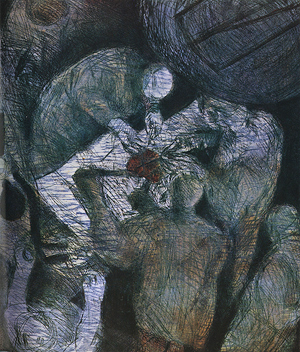

'Blood Clot'
(figure 42, page 48)
©May H. Lesser
This was an operation to drain a hematoma from a kidney of a fifteen-year-old boy. The patient was first diagnosed as having pneumonia, before the trouble was found to be a hematoma from a football injury. Much blood was lost, and once the oscilloscope did not register his pulse. Two pints of whole blood were pumped in. The surgeon's gum chewing stopped. The glass of the dome separated us as well as gave us a feeling of participating. It was how one had just felt watching Robert Kennedy assassinated on the TV screen. We responded to the event but were unable to help. We felt paralyzed. In a matter of seconds, the patient's heartbeat again registered as a trace sweeping across the oscilloscope screen. We sighed audibly as though we personally had contributed. Then we quietly realized how much "we" freshmen did not know.
As an artist, I found the scene below me was impressive because of the precise positions of the staff around the operating table: the nurse had to be where she was, the anesthesiologist had to be where he was . . . a certain beauty to the efficiency. The doctor holding the retractor assumed the same pose as Michelangelo gave the Libyan Sibyl in the Sistine Chapel. The classical poses seemed like a group sculpture.
I stayed on in the dome after this operation, and the room was readied for a liver transplant to a two-year-old child. The "last ditch" procedures were done in the afternoon. The anesthetist watching the operation alongside me commented that the answer to so many surgical exercises was in prevention. "Only we don't know enough yet about how to prevent."
Last Reviewed: May 11, 2012

